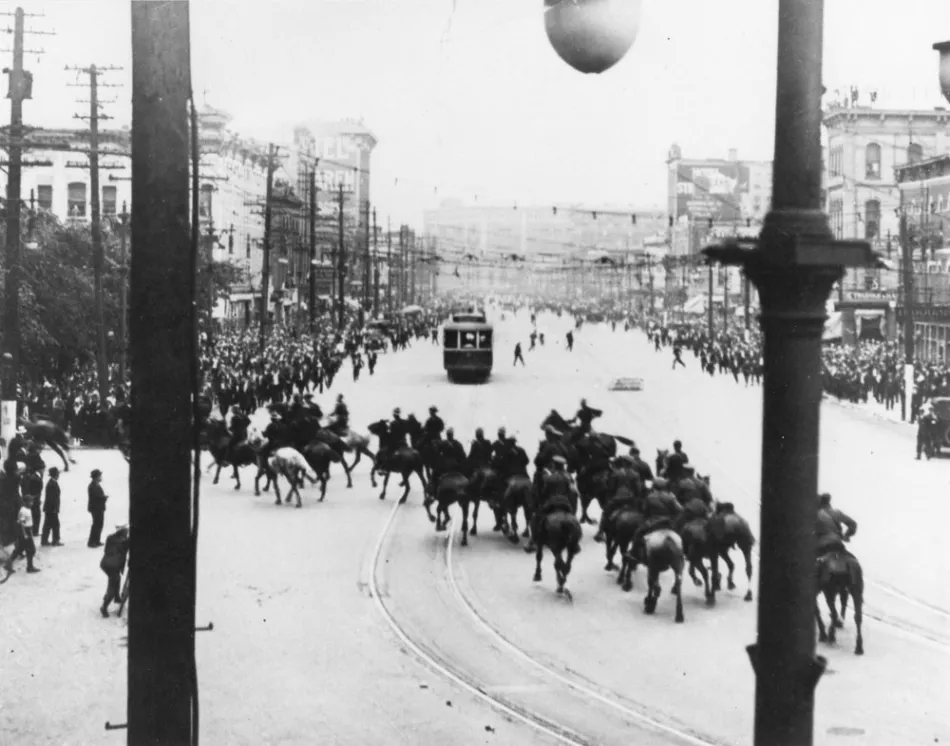100 years ago: The world surrounding the Winnipeg General Strike of 1919
By Samantha Ponting, HSA Communications
2019 marks the 100th year anniversary off the Winnipeg General Strike, when 35,000 unionized and non-unionized workers in Winnipeg walked off the job in support of striking building and metal workers.
Beginning May 15, 1919, and lasting over six weeks, the Winnipeg General Strike is a landmark historical event recognized for its expressions of working class solidarity across the city’s industrial sectors, with thousands of workers from other provinces, including British Columbia, mobilizing in support of the Winnipeg strikers through sympathy strikes.
Out on the picket line for nearly a month, 37 unions across BC joined the sympathy strikes in such cities as Victoria, Prince Rupert, New Westminster, and Prince George. In Vancouver, 10,000 workers participated.
The Winnipeg General Strike was more than just a strike. It marks a point in history where people became activated by and awakened to the grotesque inequality produced by industrial capitalism, off the heels of a devastating and seemingly senseless war waged off the backs of working class soldiers.
The strike was violently repressed. Much of the local police force was dismissed by the city’s mayor because officers were considered strike sympathizers. The business community hired and equipped 1,800 special constables to contain strike mobilizations and crack down on public assembly, alongside the Royal North-West Mounted Police, who were brought in to the city.

The special constables, or “Specials,” provoked a riot on June 10 after attempting to disperse a crowd. The same week, 12 union leaders were arrested and the union publication Western Labour News was banned. The Royal North-West Mounted Police were instructed to use any force necessary to suppress the demonstrations.
Violence culminated on June 21, known as “Bloody Saturday,” when police forces on horseback charged into a crowd of 6,000 marchers, firing bullets and killing two strikers, after a streetcar was overturned. 34 people were injured, 94 were arrested, and 7 later convicted of conspiracy to overthrow the government. The government’s violent tactics successfully ended the strike, and workers chose to return to work on June 25.
The Winnipeg General Strike was part of something bigger. It was part of a broader wave of strikes taking place across the United States and England, including the Seattle General Strike and the US coal strikes. It captured dissent to growing disenfranchisement on a global scale, as soldiers returned from WWI to communities facing widespread unemployment, inflation, and impoverishment.
While not delivering any immediate victories, the social unrest that accompanied the strike helped advance working class demands for collective bargaining rights, better pay, and better working conditions. It led to the election of strike leaders into electoral office to advance the interests of workers.
And while these victories should be celebrated, often glossed over in recounts of the strike are the different ways racism was at play during this key phase of labour history.
White working class disenfranchisement exacerbated racism, and in 1919, intense anti-black violence – including the Chicago Race Riot and at least 24 other violent events - exploded across the United States during what is called the Red Summer.
The Winnipeg General Strike was taking place amidst a backdrop of colonial violence. According to University of Manitoba Assistant Professor Niigaan Sinclair, “While First Nations by this point were locked onto reserves, the population of mixed-race Indigenous Peoples in Winnipeg was likely around 25 per cent.” Sinclair explains how the slogan of anti-strike businesses, “To hell with the alien enemy,” in part, described many Métis workers.
One of the major economic development projects at the time of the strike was established through the exploitation of Indigenous land and resources. The strike took place just three months after the Shoal Lake aqueduct project, which stole water from the Shoal Lake 40 First Nation, and brought water into the city of Winnipeg.
“It was also done by labourers who fought injustice in their workplaces, but fully perpetrated injustice in their work,” writes Sinclair, highlighting some of the contradictions inherent in the Winnipeg labour movement, which was dominated by white leadership.
Sinclair also notes that it was largely Métis workers whose jobs were displaced following the aqueduct project, who beforehand played the fundamental role of delivering water door-to-door.
Sinclair encourages us to understand the state of Indigenous-Settler relations in 1919 in our examination of the strike.
Indeed, it occurred just one year before the Indian Act was amended to force Indigenous families into the residential school system, as Sinclair highlights, and it shadowed two decades of violent policies banning Indigenous cultural practices. “This was the world surrounding the Winnipeg General Strike of 1919,” he writes.
As the centennial anniversary of the Winnipeg General Strike comes to a close, we can take inspiration from an event whereby workers stood up for themselves on a massive scale and demanded change. It’s also an opportune moment to examine how the labour movement can move forward in the face of ongoing challenges to strengthen workplace rights, build connections with the community, and work in solidarity with Indigenous peoples within the context of Canadian colonialism.
This article originally appeared in the December 2019 issue of HSA's magazine The Report. To read the full issue, click here.
Photo credit: Winnipeg 1919 June 21 - Royal Canadian Mounted Police, Library and Archives Canada e004666108